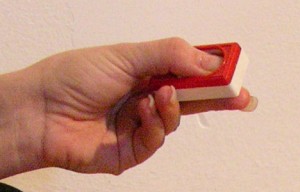Parents of children on the autism spectrum by necessity become keen observers of their child’s behavior.
We are ever vigilant, watching for signs of an impending meltdown, or to appreciate those wonderful, elusive flashes of understanding or emotional connection.
Our beautiful kids have shining moments of great behavior when they are happy and all is right in their confusing world.
Wouldn’t you like to have more of those moments, and have those moments last longer?
Study what the child is already doing
An easy and effective way to get more of those shining moments is to start with something that the child is already doing (even if it is only fleetingly) and increase the strength of that behavior. By behavior, I mean a physical movement that the child is doing (as opposed to “good,” “bad” or other emotional descriptions of what is happening). If your child is shrieking and running around, he is not “driving you crazy,” he is demonstrating a behavior, i.e., the physical movements of moving his feet and moving his vocal chords.
Dr. Martin Kozloff, in his excellent book: Educating Children with Learning and Behavior Problems suggests that you take five minutes and observe your child, recording every movement of every body part. This will give you objective information of what actual physical movements your child is making. Once you have a catalog of the child’s movements, you can decide which ones could be the basis of new, “good” behaviors. We have created a download for you to use in recording your child’s movements that has additional instructions.
Look for Behaviors With Potential
Record as many physical movements as you can and make specific notes about them. If the child is running, does he alternate both feet consistently or do a run/bounce/hop movement? Include the behaviors that you like even if they are fleeting. Some examples of good physical movements are a split second of Both Feet on the Ground, Quiet Mouth, Hands Still or Eye Contact. If nothing else, your child must breathe, so the type of breathing is something to note (is the child’s breathing rapid and irregular or is he inhaling and exhaling calmly).
After you have made your observations, review the list and mark with a highlighter those behaviors that you want to increase, even if they only happened for a fraction of a second. Choose two or three of these to work on at first, make a list of these and post them around the house to remind yourself (and others in the house) to be on the lookout for them as well.
Mark and Reinforce to Increase Desirable Behaviors
Say for example, your child bounces up and down, but there are moments when both feet are on the floor. You could choose this as the first behavior to work on. Each time you see both feet on the floor, mark and reinforce. By this I mean mark the occurrence of Feet On Floor/Ground with a short, sharp sound from a tagger (clicker). This signals to the child that he is doing a behavior that you like. Follow the mark immediately with a food treat (something small and quickly consumable that the child likes). Soon your smart and sensitive child will figure out that having both feet on the floor is earning reinforcement. He will begin to offer Feet On Floor/Ground on purpose to get you to click. He may start to experiment with the other movements to see what will earn reinforcement and praise. The game is on!
Expand Your Horizons
Soon you will be able to delay the mark for a second and then 2 sec and longer to increase duration. Then you can practice in other rooms of the house, then outside and then elsewhere.
Refer back to your chart to choose other behaviors to work on. Repeat the observation exercise every week, highlighting the behaviors that you like, and you will start to notice that over time you have a lot more yellow highlighter on the sheet than you did the first time.
Download the Behavior Chart and Instructions
Leave a comment below and let me know how this is working for you!
What is TAGteach
TAGteach stands for Teaching with Acoustical Guidance. TAGteach is a teaching and communication method based on the scientific principles of Applied Behavior Analysis (ABA).
TAGteach enables extremely precise positive reinforcement of behavior by using an acoustical signal to “mark” the behavior – at the precise moment the child performs the behavior! The acoustical signal is a short, sharp sound made by a handheld device (the “tagger”). When the child performs the correct action, the parent/instructor immediately presses the button on the tagger and hands over a treat (candy, treat, token, praise, social recognition, or money) as a reinforcer.
With TAGteach, it is easy to reinforce behaviors precisely and quickly. The immediate, accurate feedback and positive reinforcement result in the child performing the correct action more often, and for longer periods of time. With immediate feedback and learning tasks broken down into small steps, children can learn many new skills with TAGteach — at their own pace.
 Join the free TAGteach listserve.
Join the free TAGteach listserve.
TAGteach taggers are available here.
See Martha’s book about TAGteach for Autism or ask a question (with no obligation).
to receive updates, new articles and free tips right in your inbox!
If you liked this post, please share it on social media via the vertical gray menu on the far right.
